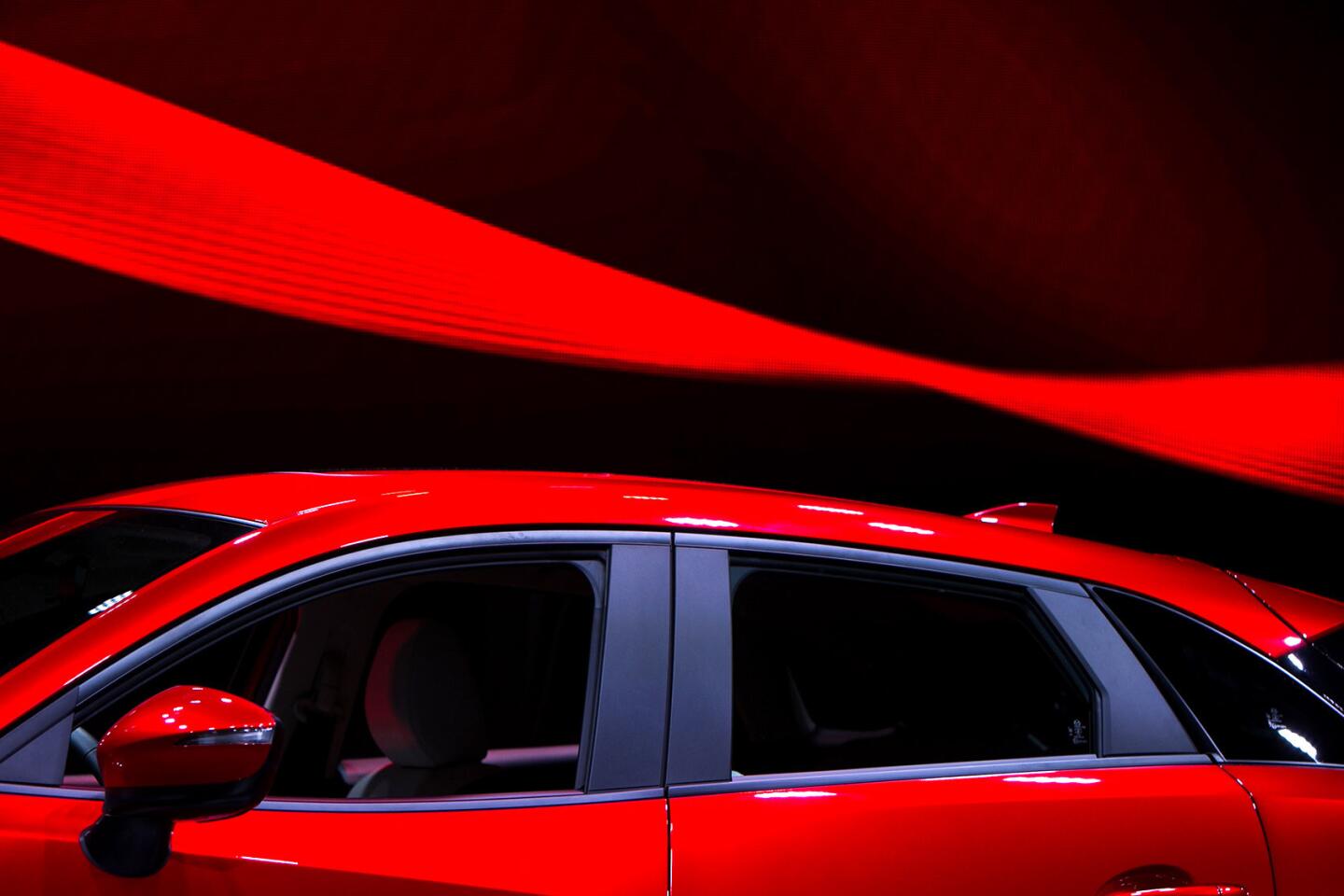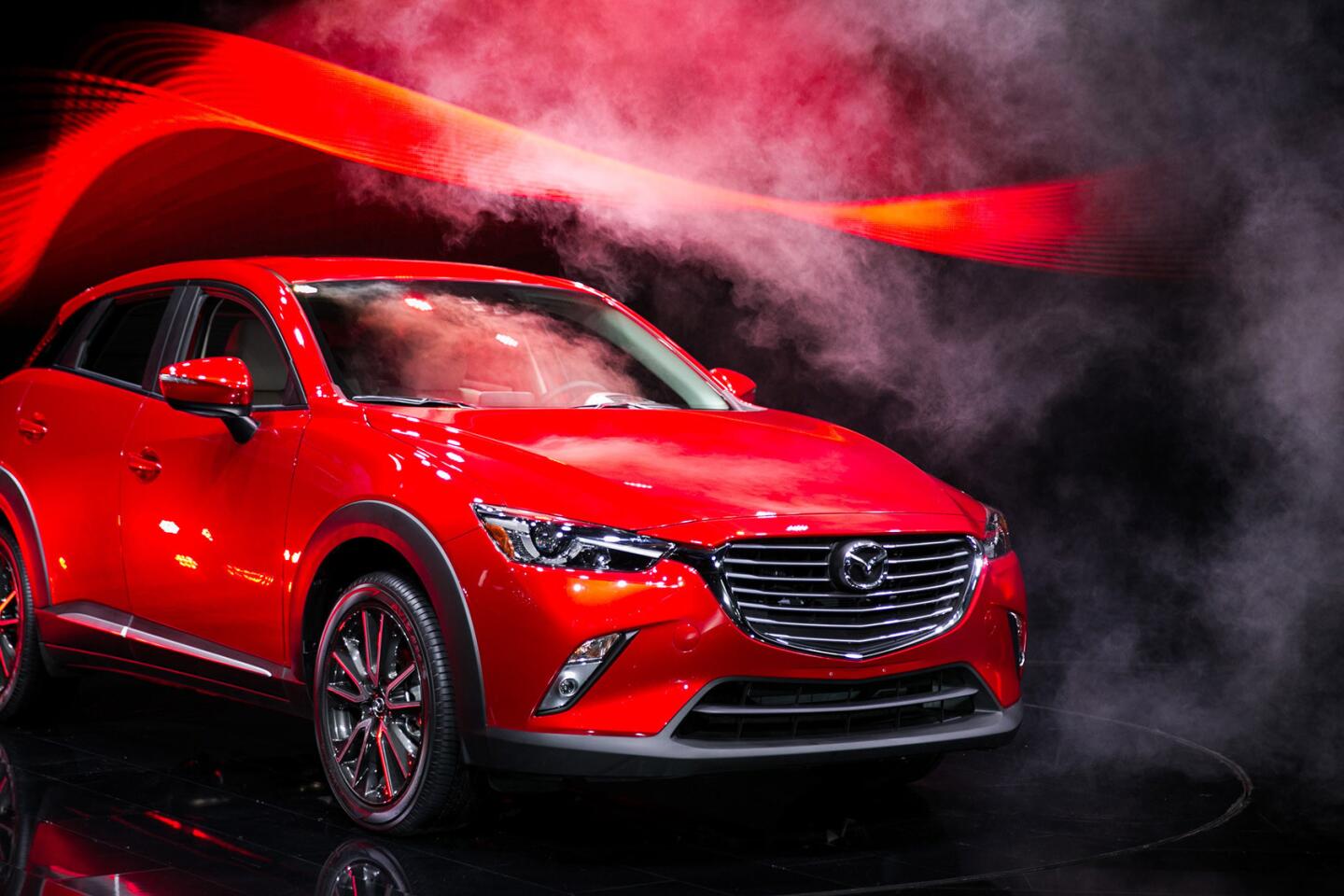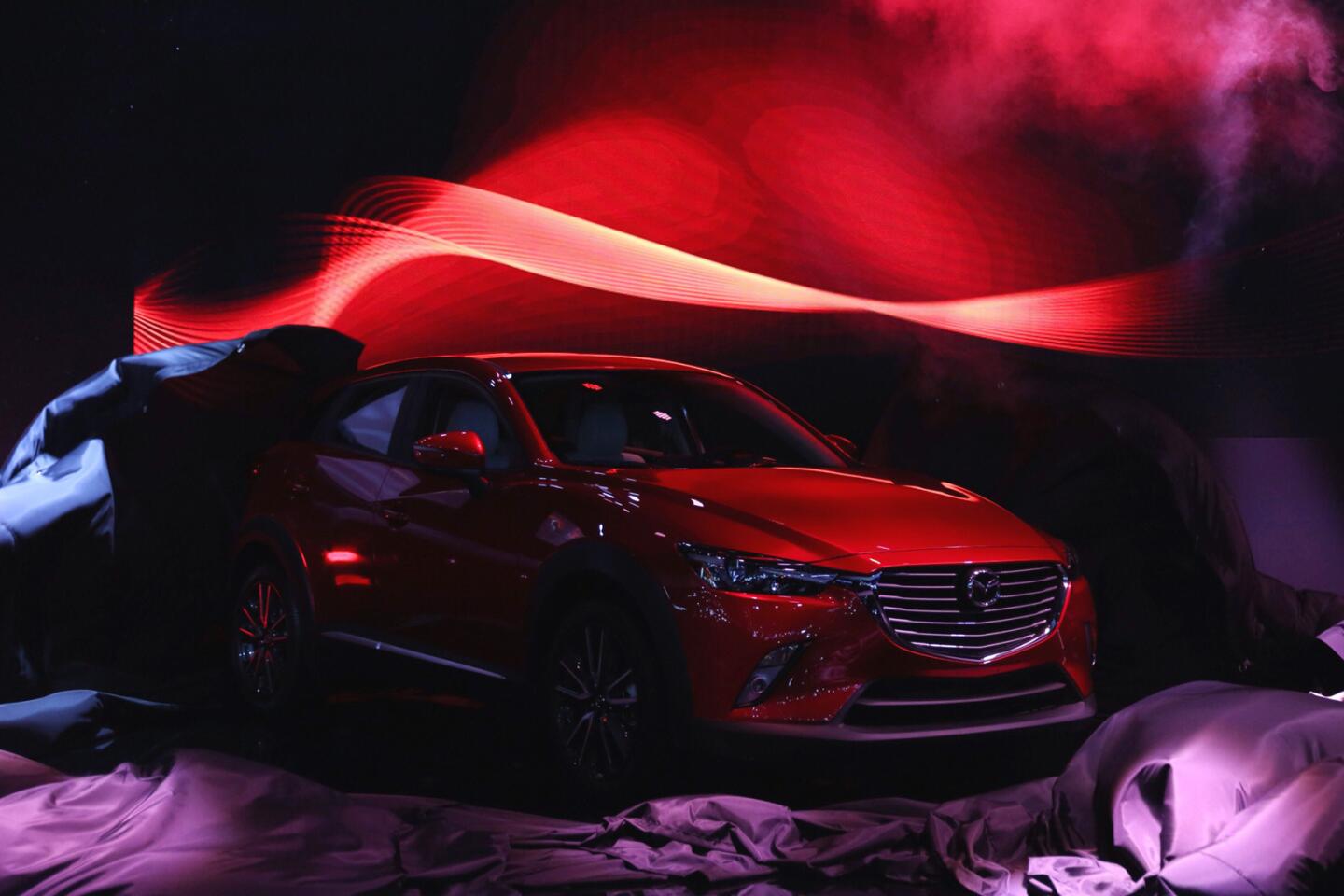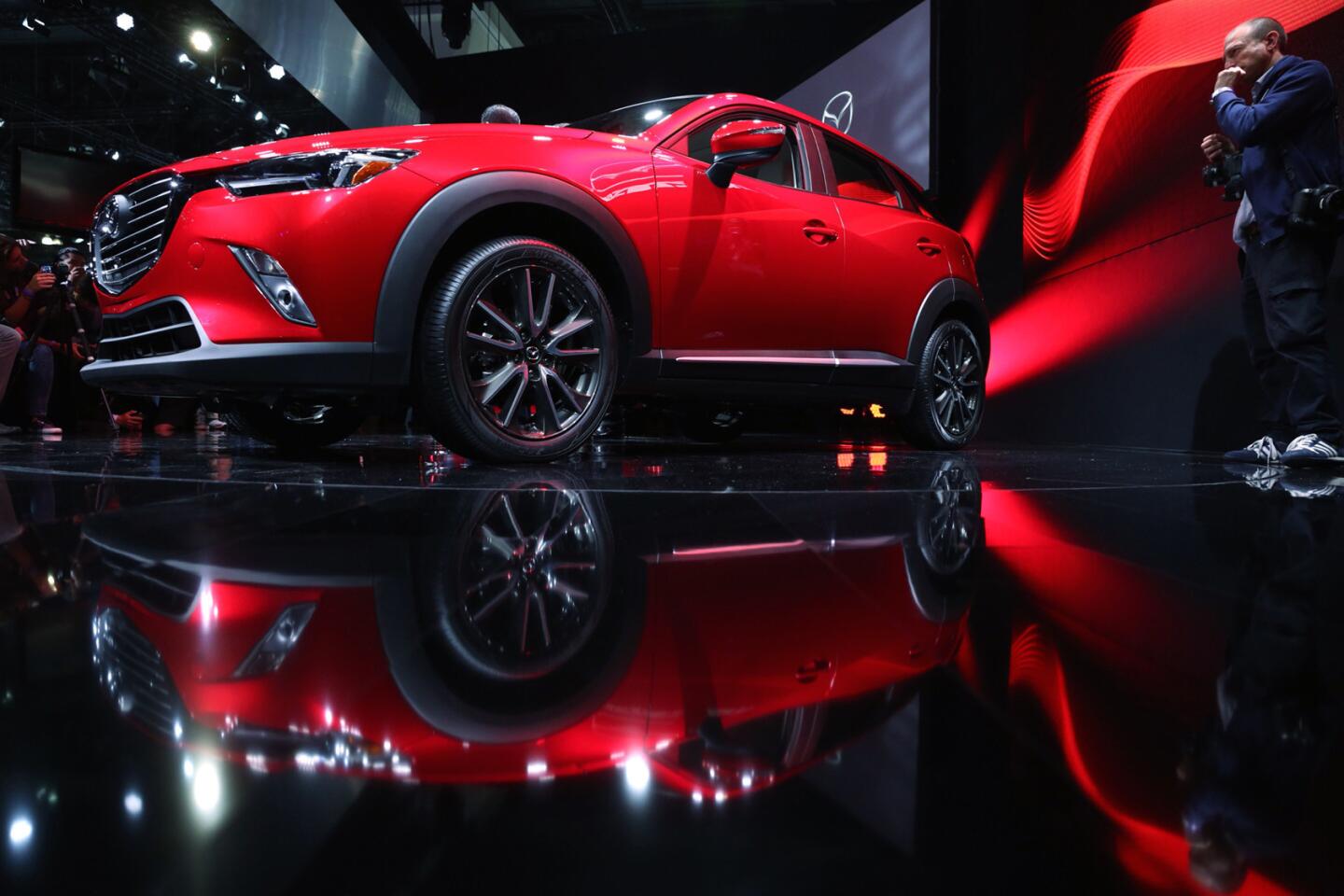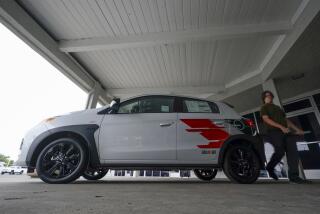Mazda targets new CX-3 crossover to drive sales higher
Judging from Mazda’s existing portfolio of vehicles, its new CX-3 crossover — set to debut Wednesday at the Los Angeles Auto Show — will be a well-designed, durable, nimble vehicle.
But if history is any guide, relatively few people will buy it.
Mazda has long been loved by critics but often ignored by buyers, who flock to comparable Toyotas or Hondas in numbers that dwarf Mazda’s sales.
Mazdas are among Consumer Reports’ top picks. Only Toyota has a better reliability record, the magazine said. Mazda’s fuel efficiency beats all other brands, the Environmental Protection Agency reported this year. Motor Trend named the 2014 Mazda6 the top mid-sized sedan.
Yet the accolades have done little for the company’s bottom line. Mazda has sold just 45,000 of its Mazda6 sedans this year, about 12% of Toyota Camrys sold. Although the brand has had a modest sales increase this year, its U.S. sales growth over the last five years has lagged the industry’s by a wide margin — 37% compared with 50%.
Mazda hopes another strong model, in the hottest segment of the auto market, will put the company on the road to bigger sales.
“We have seen some very dark times at this company but we have also seen some very wonderful times,” said James O’Sullivan, chief executive of Mazda North American Operations in Irvine, at the company’s news conference Wednesday morning. “If you judge success by the cars you sell...we are on an unstoppable roll.”
The five-passenger CX-3 shares architecture with the Mazda2 subcompact sedan and a 2.0-liter, four-cylinder engine with the larger Mazda3. It will compete in a burgeoning field of small crossovers that includes the Buick Encore and Honda’s HR-V. The Honda is also set to debut at this week’s L.A. Auto Show.
“This will be one of the bigger opportunities in the industry,” O’Sullivan said. “We are going to be one of the first movers in this category.”
Small crossovers, which also include Mazda’s slightly larger CX-5 and the top-selling Honda CR-V, are the fastest-growing segment of U.S. auto sales. The vehicles are car-based, family-hauling SUVs that have replaced the station wagon in American culture.
“As people’s lifestyle changes, they get married or have kids, they need something a little bigger, but they are not going into another sedan, they go into a crossover,” O’Sullivan said.
Mazda is already having some success in the segment. Sales of the automaker’s CX-5 are running 27% ahead of last year and now account for about a third of Mazda’s U.S. sales. An updated CX-5, for the 2016 model year, also is set to debut in L.A. on Wednesday.
“The success of CX-5 has good implications for Mazda in the compact crossover SUV segment,” said Jonathan Mandanici, an analyst for car-shopping website Edmunds.com.
Indeed, the CX-5 could topple the company’s Mazda3 sedan from its perch as the brand’s bestseller. Mazda needs the smaller CX-3 to put up similar numbers if it expects to perform like other small automakers, such as Subaru.
Coming out of the recession in 2009, Mazda and Subaru both sold about 210,000 vehicles in the U.S. Each had a 2% market share.
Their courses then diverged. Subaru has doubled its sales since then and now has more than 3% of the market. Mazda sales have risen at a much slower pace, trailing the industry at large. Its market share has dipped below 2%.
It’s not that Subarus are all that different from Mazdas. Both are Japanese brands. Both get good marks from Consumer Reports for reliability — Mazda is actually ahead. Both make a range of vehicles — compacts, sedans, crossovers — and neither sells luxury cars. Both generally offer vehicles with good fuel economy.
Subaru credits its growth to a fresh model lineup, featuring vehicles that have grown in size while still improving fuel economy. They have also added improved engines, transmissions and in-dash technology. All but one of its models are all-wheel-drive vehicles, a segment that has done well since last year’s harsh winter in much of the nation.
“Subaru has captured the place that Volvo once held for selling that family-friendly, safe car,” said Jack Nerad, an analyst with car shopping service Kelley Blue Book.
Mazda, by contrast, has traditionally rooted its brand identity in building sporty cars that handle well. That’s important to some consumers, but not enough of them to significantly boost sales. Sportiness also has its tradeoffs, like a slightly rougher ride or more interior noise.
That has given Mazda a more complicated pitch, reaching out to independent, adventurous drivers, Nerad said. Still, because of its smaller size, Mazda can’t just expect to “ape Toyota and have a similar success,” Nerad said.
That’s not Mazda’s plan, O’Sullivan said.
“We know that many people are commodity buyers who don’t care about driving dynamics. They have just bought Toyotas and that is what they are comfortable with,” he said. “The Mazda brand is for enthusiasts — people who care about quality, safety, fuel economy and great driving characteristics.”
Some things are going well for Mazda.
Sales are up 8.1% this year — above the 5.5% industry average. It also has among the youngest buyers in the industry. A Mazda buyer’s median age is 48, according to last year’s Maritz New Vehicle Customer Survey. That compares with 55 for the industry.
O’Sullivan said the new crossover will provide an entry point for new buyers, whom he believes will return to the brand to purchase the larger CX-5 and even the seven-seat CX-9 as their needs change.
By other measures, Mazda is doing better than other automakers, said John Krafcik, the former top executive for Hyundai in the U.S. and now the president of car shopping service TrueCar.com.
“We spend too much time counting vehicle unit sales and not enough time looking at revenue,” Krafcik said.
It turns out that Mazda is getting good money for the cars it does sell. The Mazda6 has an average transaction price of more than $25,400, according to industry data. That’s about $300 more than the Toyota Camry and $900 more than the Honda Accord.
TrueCar estimates that Mazda’s U.S. car sales revenue through the end of October has risen 10.4% compared with the same period a year earlier. That is the largest increase of all Japanese automakers, except Subaru. Mazda pushed average transaction prices higher by reducing incentives and discounts.
“While more volume is always nice, the one thing we are focusing on is the quality of our business, not the quantity,”
O’Sullivan believes sales volume will grow with each successive redesign of the models in Mazda’s lineup.
The automaker has adopted what it calls Skyactiv technology. The goal is to shave weight from the vehicle and wring efficiency out of a standard gasoline engine and drivetrain without employing hybrid technology or continuously variable transmissions.
It has put its top sellers, the Mazda3, the CX-5 and Mazda6, through the process. The CX-3 and MX-5 — the sports car also known as the Miata — go on sale next year having gone through the same design approach.
Each new Skyactiv vehicle sees a sales bump over the previous generation, O’Sullivan said.
The higher transaction prices demonstrate that Mazda “appeals to pragmatic, affluent folks who do lots of due diligence and research and are willing to pay more for a high-quality product with a sporty edge,” Krafcik said.
Mazda’s problem, he said, is a lack of brand awareness among buyers. The company doesn’t make it onto enough shopping lists. That can be cured only by the automaker’s U.S. executives persuading their bosses back in Hiroshima to send over more money for marketing, Krafcik said.
“You never get all that you want,” O’Sullivan said. “But we are getting what we need.”
twitter:latimesjerry
More to Read
Inside the business of entertainment
The Wide Shot brings you news, analysis and insights on everything from streaming wars to production — and what it all means for the future.
You may occasionally receive promotional content from the Los Angeles Times.
